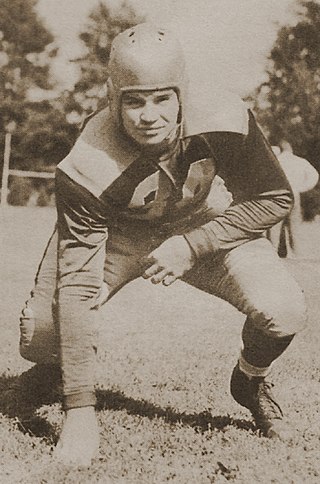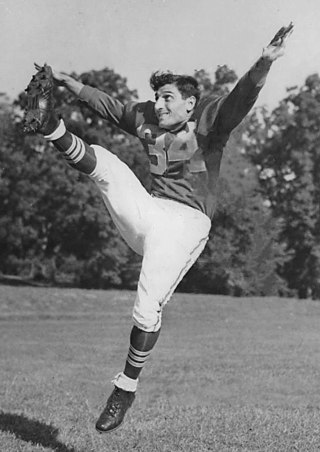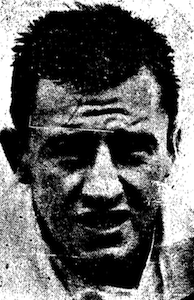Related Research Articles

Anthony Adamle was an American professional football player who was a linebacker and fullback in the All-America Football Conference (AAFC) and the National Football League (NFL). He played his entire career for the Cleveland Browns before retiring to pursue a medical degree.

Mac Curtis Speedie was an American professional football end who played for the Cleveland Browns in the All-America Football Conference (AAFC) and the National Football League (NFL) for seven years before joining the Saskatchewan Roughriders in Canada. He later served for two years as head coach of the American Football League's Denver Broncos. A tall and quick runner whose awkward gait helped him deceive defenders and get open, Speedie led his league in receptions four times during his career and was selected as a first-team All-Pro six times. His career average of 800 yards per season was not surpassed until two decades after his retirement, and his per-game average of 50 yards went unequalled for 20 years after he left the game.
The 1946 Cleveland Browns season was the team's first in the All-America Football Conference (AAFC). The Browns, coached by Paul Brown, ended the year with a record of 12–2, winning the AAFC's Western Division. Led by quarterback Otto Graham, fullback Marion Motley and ends Dante Lavelli and Mac Speedie, the team won the first AAFC championship game against the New York Yankees.
The 1947 Cleveland Browns season was the team's second in the All-America Football Conference (AAFC). Led by head coach Paul Brown, Cleveland finished with a 12–1–1 record, winning the Western division and the AAFC championship for the second straight year. As in 1946, quarterback Otto Graham led an offensive attack that featured fullback Marion Motley, ends Dante Lavelli, and Mac Speedie.
The 1948 Cleveland Browns season was the team's third in the All-America Football Conference (AAFC). After winning the AAFC crown in 1946 and 1947, the league's first two years of existence, the Browns repeated as champions in 1948 and had a perfect season, winning all of their games.
The 1949 Cleveland Browns season was the team's fourth and final season in the All-America Football Conference (AAFC). The Browns finished the regular season with a 9–1–2 win–loss–tie record and beat the San Francisco 49ers to win their fourth straight league championship. In the season's sixth game on October 9, the 49ers stopped the Browns' professional football record unbeaten streak at 29 games. It began two years earlier on October 19, 1947, and included two league championship games and two ties.
The 1950 Cleveland Browns season was the team's first in the National Football League (NFL) after playing the previous four years in the All-America Football Conference (AAFC), which folded after the 1949 season. The Browns finished the regular season with a 10–2 win–loss record and beat the Los Angeles Rams to win the NFL championship. It was Cleveland's fifth consecutive championship victory, the previous four having come in the AAFC.

Warren Emmett Lahr was an American professional football player who was a defensive back who played for the Cleveland Browns for 11 seasons, mainly in the 1950s. When he retired, he had the most career interceptions in Browns team history with 44.

James Lachlan Daniell, nicknamed "Big Jim", was an American football offensive tackle and defensive tackle, a World War II veteran, and a steel company executive. He played two years in the National Football League (NFL) and All-America Football Conference (AAFC).

Chester Frank Adams was a professional American football tackle and placekicker who played ten seasons in the National Football League (NFL) and All-America Football Conference (AAFC), mainly with the Cleveland Rams and Cleveland Browns. He was selected to the NFL's All-Star game twice. In 1978, he was inducted into the Greater Cleveland Sports Hall of Fame.

Lindell Lee Houston was an American football guard who played eight seasons in the All-America Football Conference (AAFC) and in the National Football League (NFL) with the Cleveland Browns. He was the older brother of Jim Houston.

Thomas Anthony Colella was an American professional football halfback, punter and safety who played in the National Football League (NFL) and All-America Football Conference (AAFC) for the Detroit Lions, the Cleveland Rams, the Cleveland Browns and the Buffalo Bills.

George Donald Young was an American football defensive end who played eight seasons in the All-America Football Conference (AAFC) and in the National Football League (NFL) with the Cleveland Browns. He later was an umpire officiating in the American Football League (AFL) for its entire existence, from 1960 through 1969. He officiated in the first AFL championship in 1960 and the first Super Bowl after the 1966 season.

John Patrick Harrington was a professional American football end and defensive end who played two seasons for the Cleveland Browns and Chicago Rockets in the All-America Football Conference (AAFC). Harrington attended Marquette University and became the football team's captain in 1942. He joined the military in 1944 and played for Air Force teams in 1944 and 1945. He was drafted by the Chicago Cardinals in 1945 but instead signed with the Browns before the team's inaugural season in 1946. Harrington played in one season for the Browns before he was traded to the Rockets in 1947.

Michael Joseph “Mo” Scarry was an American football player and coach. He grew up in Pennsylvania, and played football in college at Waynesburg College in Waynesburg, Pennsylvania and went on to join the Cleveland Rams in the National Football League (NFL) as a center following a stint in the U.S. Army during World War II. The Rams moved to Los Angeles after winning the 1945 NFL championship, and Scarry elected to stay in Cleveland and play for the Cleveland Browns under coach Paul Brown in the new All-America Football Conference (AAFC). The Browns won the AAFC championship in 1946 and 1947 while Scarry was on the team.

Frederick Owen "Dippy" Evans Jr. was a professional American football halfback who played for three years in the All-America Football Conference (AAFC) and the National Football League (NFL) in the late 1940s.

William Harold Lund was an American professional football player who was a halfback for two seasons for the Cleveland Browns in the All-America Football Conference (AAFC).

James Alexander Dewar Jr. was an American football halfback who played two seasons in the All-America Football Conference (AAFC). Dewar played for the Cleveland Browns in 1947 and the Brooklyn Dodgers in 1948.

Robert George Cowan was an American football halfback who played three seasons in the All-America Football Conference (AAFC) between 1947 and 1949. Cowan played for the Cleveland Browns and the Baltimore Colts.

Angelo Robert Gaudio was an American football guard who played four seasons for the Cleveland Browns in the All-America Football Conference (AAFC) and National Football League (NFL) between 1947 and 1951.
References
- 1 2 3 4 5 6 Piascik 2007, p. 71.
- 1 2 3 4 Sauerbrei, Harold (August 7, 1949). "Boedeker Isn't Reckless Runner". Cleveland Plain Dealer. p. 3C.
- ↑ King, Steve. "Browns have military history". Cleveland Browns. Archived from the original on March 14, 2014. Retrieved September 19, 2012.
- 1 2 "Readers sound off on Top 26 athletes". Fort Wayne Journal Gazette. August 9, 2009. Archived from the original on February 18, 2012. Retrieved September 15, 2012.
- ↑ Sauerbrei, Harold (August 28, 1947). "Boedeker Is Good Man At Returning Kickoffs". Cleveland Plain Dealer. Bowling Green, O. p. 17.
- ↑ Piascik 2007, p. 81.
- ↑ Piascik 2007, p. 121.
- ↑ Piascik 2007, pp. 141, 146.
- ↑ Cobbledick, Gordon (December 23, 1947). "Plain Dealing". Cleveland Plain Dealer. p. 14.
- ↑ "Eagle Back Inducted". Cleveland Plain Dealer. Philadelphia. Associated Press. December 5, 1950. p. 25.
- ↑ "Bill Boedeker NFL Football Statistics". Pro Football Reference. Archived from the original on October 20, 2012. Retrieved September 15, 2012.
- 1 2 "Boedeker Is Given Promotion by Firm". Cleveland Plain Dealer. December 7, 1952. p. 3C.
- ↑ Hickey, William (November 19, 1965). "This Sporting Life". Cleveland Plain Dealer. p. 40.
- ↑ "WILLIAM H. BOEDEKER Jr". The News-Sentinel . Ogden Newspapers. March 24, 2014. Retrieved March 24, 2014.
Bibliography
- Piascik, Andy (2007). The Best Show in Football: The 1946–1955 Cleveland Browns. Lanham, MD: Taylor Trade Publishing. ISBN 978-1-58979-571-6.